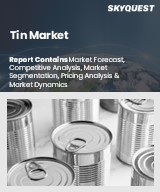
|
시장보고서
상품코드
1677902
솔더 재료 시장 규모, 점유율, 성장 분석 : 합금 유형별, 플럭스 유형별, 용도별, 형태별, 프로세스별, 지역별 - 산업 예측(2025-2032년)Solder Materials Market Size, Share, and Growth Analysis, By Alloy Type (Lead-Based Solder, Lead-Free Solder), By Flux Type (Rosin-Based Flux, No-Clean Flux), By Applications, By Form, By Process, By Region - Industry Forecast 2025-2032 |
||||||
솔더 재료 시장 규모는 2023년에 300억 달러에 달하며, 예측 기간(2025-2032년)의 CAGR은 4.0%로, 2024년 312억 달러에서 2032년에는 427억 달러로 성장할 전망입니다.
세계 솔더 소재 시장은 스마트폰, 태블릿, 노트북 등 전자기기 수요 증가에 힘입어 상승세를 보이고 있습니다. 특히 5G, AI 등의 급속한 기술 발전이 시장 성장을 크게 견인하고 있으며, 소형화 추세로 인해 전도성 및 열전도성이 우수한 솔더 소재가 요구되고 있습니다. 또한 환경에 대한 인식이 높아지면서 무연 솔더의 보급을 촉진하고 있습니다. 내식성과 극한의 온도에서 안정성을 제공하는 고성능 소재에 대한 수요는 더욱 증가하고 있습니다. 자동차, 항공우주 등의 산업은 첨단 전자 시스템을 필요로 하므로 큰 비즈니스 기회가 될 수 있습니다. 전기자동차 및 하이브리드차의 생산이 증가함에 따라 전자 부문은 향후 4년동안 솔더 재료에 대한 견고한 수요를 보장하는 주요 견인차 역할을 계속할 것입니다.
목차
서론
- 조사의 목적
- 조사 범위
- 정의
조사 방법
- 정보 조달
- 2차와 1차 데이터 방법
- 시장 규모 예측
- 시장의 전제조건과 제한
개요
- 세계 시장 전망
- 공급과 수요 동향 분석
- 부문별 기회 분석
시장 역학과 전망
- 시장 개요
- 시장 규모
- 시장 역학
- 촉진요인과 기회
- 억제요인과 과제
- Porter의 산업 분석
주요 시장 인사이트
- 주요 성공 요인
- 경쟁의 정도
- 주요 투자 기회
- 시장 에코시스템
- 시장의 매력 지수(2024년)
- PESTEL 분석
- 거시경제 지표
- 밸류체인 분석
- 가격 분석
솔더 재료 시장 규모 : 합금 유형별 & CAGR(2025-2032)
- 시장 개요
- 납 솔더
- 납프리 솔더
- 특수 솔더
솔더 재료 시장 규모 : 플럭스 유형별 & CAGR(2025-2032)
- 시장 개요
- 로진계 플럭스
- 노 클린 플럭스
- 수용성 플럭스
솔더 재료 시장 규모 : 용도별 & CAGR(2025-2032)
- 시장 개요
- 전자기기
- 자동차
- 항공우주
- 산업 기계
솔더 재료 시장 규모 : 형태별 & CAGR(2025-2032)
- 시장 개요
- 페이스트
- 와이어
- 바
- 프리폼
솔더 재료 시장 규모 : 프로세스별 & CAGR(2025-2032)
- 시장 개요
- 웨이브/리플로우
- 스크린 인쇄
- 레이저
- 로봇
솔더 재료 시장 규모 : 지역별 & CAGR(2025-2032)
- 북미
- 미국
- 캐나다
- 유럽
- 독일
- 스페인
- 프랑스
- 영국
- 이탈리아
- 기타 유럽 지역
- 아시아태평양
- 중국
- 인도
- 일본
- 한국
- 기타 아시아태평양
- 라틴아메리카
- 브라질
- 기타 라틴아메리카 지역
- 중동 및 아프리카
- GCC 국가
- 남아프리카공화국
- 기타 중동 및 아프리카
경쟁 정보
- 상위 5사의 비교
- 주요 기업의 시장 포지셔닝(2024년)
- 주요 시장 기업이 채택한 전략
- 최근 시장 동향
- 기업의 시장 점유율 분석(2024년)
- 주요 기업의 기업 개요
- 기업의 상세
- 제품 포트폴리오 분석
- 기업의 부문별 점유율 분석
- 매출의 전년대비 비교(2022-2024)
주요 기업 개요
- Indium Corporation(USA)
- Alpha Assembly Solutions(USA)
- AIM Solder(Canada)
- Kester(USA)
- Senju Metal Industry Co., Ltd.(Japan)
- Nihon Superior Co., Ltd.(Japan)
- Heraeus Holding GmbH(Germany)
- MBO Osswald GmbH & Co. KG(Germany)
- Qualitek International, Inc.(USA)
- TAMURA Corporation(Japan)
- Inventec Performance Chemicals(France)
- Fusion Incorporated(USA)
- KOKI Company Limited(Japan)
- Metallic Resources, Inc.(USA)
- Shenzhen Jufeng Solder Co., Ltd.(China)
- Canfield Technologies(USA)
- Balver Zinn Josef Jost GmbH & Co. KG(Germany)
- Stannol GmbH & Co. KG(Germany)
- Advanced Joining Technology(USA)
- Henkel AG & Co. KGaA(Germany)
결론과 제안
KSA 25.04.18Solder Materials Market size was valued at USD 30.0 billion in 2023 and is poised to grow from USD 31.2 billion in 2024 to USD 42.7 billion by 2032, growing at a CAGR of 4.0% during the forecast period (2025-2032).
The global solder materials market is on an upward trajectory, fueled by the rising demand for electronic devices such as smartphones, tablets, and laptops. Rapid technological advancements, particularly in 5G and AI, are significantly propelling market growth, while the trend toward miniaturization necessitates solder materials with superior electrical and thermal conductivity. Additionally, the rise in eco-consciousness is driving the popularity of lead-free solder options. Demand is further amplified for high-performance materials that offer corrosion resistance and stability under extreme temperatures. Industries such as automotive and aerospace present substantial opportunities as they require advanced electronic systems. As production of electric and hybrid vehicles increases, the electronic sector will continue to be the primary driver, ensuring robust demand for solder materials over the next four years.
Top-down and bottom-up approaches were used to estimate and validate the size of the Solder Materials market and to estimate the size of various other dependent submarkets. The research methodology used to estimate the market size includes the following details: The key players in the market were identified through secondary research, and their market shares in the respective regions were determined through primary and secondary research. This entire procedure includes the study of the annual and financial reports of the top market players and extensive interviews for key insights from industry leaders such as CEOs, VPs, directors, and marketing executives. All percentage shares split, and breakdowns were determined using secondary sources and verified through Primary sources. All possible parameters that affect the markets covered in this research study have been accounted for, viewed in extensive detail, verified through primary research, and analyzed to get the final quantitative and qualitative data.
Solder Materials Market Segments Analysis
Global Solder Materials Market is segmented by Alloy Type, Flux Type, Applications, Form, Process and region. Based on Alloy Type, the market is segmented into Lead-Based Solder, Lead-Free Solder and Specialty Solder. Based on Flux Type, the market is segmented into Rosin-Based Flux, No-Clean Flux and Water-Soluble Flux. Based on Applications, the market is segmented into Electronics, Automotive, Aerospace and Industrial Machinery. Based on Form, the market is segmented into Paste, Wire, Bar and Preforms. Based on Process, the market is segmented into Wave/reflow, Screen Printing', Laser and Robotic. Based on region, the market is segmented into North America, Europe, Asia Pacific, Latin America and Middle East & Africa.
Driver of the Solder Materials Market
The increasing demand for consumer electronics such as smartphones, laptops, and wearable devices is a primary catalyst for the growth of the global solder materials market. As technological advancements progress, manufacturers require advanced solder materials to ensure optimal performance, enhance miniaturization, and provide long-lasting durability in increasingly complex electronic devices. This trend is fueling the need for innovative solder solutions that can meet the stringent requirements of modern electronics. Consequently, the solder materials market experiences significant expansion as industry players strive to keep up with the evolving landscape of consumer technology and its corresponding fabrication needs.
Restraints in the Solder Materials Market
The global solder materials market faces significant constraints primarily due to supply chain disruptions, which can severely impact production timelines and costs. Factors such as transportation bottlenecks, geopolitical tensions, and shortages of critical raw materials contribute to these challenges, resulting in delays in the availability of solder materials. This instability creates difficulties for manufacturers across multiple sectors, hindering their ability to meet demand and maintain efficiency. Consequently, these disruptions not only affect production schedules but also increase operational costs, posing a notable challenge for businesses operating within the solder materials market.
Market Trends of the Solder Materials Market
The solder materials market is experiencing a significant shift towards lead-free soldering solutions, propelled by stringent environmental regulations and growing health concerns associated with lead exposure. This trend reflects a broader commitment to sustainability within various industries, where manufacturers increasingly adopt eco-friendly alternatives such as SAC (Tin-Silver-Copper) alloys. As a result, the demand for innovative lead-free solder technologies is surging, prompting investments in research and development to enhance performance and reliability. The market is thus evolving, with a clear emphasis on sustainable practices, driving both product innovation and changes in manufacturing processes across the electronics and automotive sectors.
Table of Contents
Introduction
- Objectives of the Study
- Scope of the Report
- Definitions
Research Methodology
- Information Procurement
- Secondary & Primary Data Methods
- Market Size Estimation
- Market Assumptions & Limitations
Executive Summary
- Global Market Outlook
- Supply & Demand Trend Analysis
- Segmental Opportunity Analysis
Market Dynamics & Outlook
- Market Overview
- Market Size
- Market Dynamics
- Drivers & Opportunities
- Restraints & Challenges
- Porters Analysis
- Competitive rivalry
- Threat of substitute
- Bargaining power of buyers
- Threat of new entrants
- Bargaining power of suppliers
Key Market Insights
- Key Success Factors
- Degree of Competition
- Top Investment Pockets
- Market Ecosystem
- Market Attractiveness Index, 2024
- PESTEL Analysis
- Macro-Economic Indicators
- Value Chain Analysis
- Pricing Analysis
Global Solder Materials Market Size by Alloy Type & CAGR (2025-2032)
- Market Overview
- Lead-Based Solder
- Lead-Free Solder
- Specialty Solder
Global Solder Materials Market Size by Flux Type & CAGR (2025-2032)
- Market Overview
- Rosin-Based Flux
- No-Clean Flux
- Water-Soluble Flux
Global Solder Materials Market Size by Applications & CAGR (2025-2032)
- Market Overview
- Electronics
- Automotive
- Aerospace
- Industrial Machinery
Global Solder Materials Market Size by Form & CAGR (2025-2032)
- Market Overview
- Paste
- Wire
- Bar
- Preforms
Global Solder Materials Market Size by Process & CAGR (2025-2032)
- Market Overview
- Wave/reflow
- Screen Printing'
- Laser
- Robotic
Global Solder Materials Market Size & CAGR (2025-2032)
- North America (Alloy Type, Flux Type, Applications, Form, Process)
- US
- Canada
- Europe (Alloy Type, Flux Type, Applications, Form, Process)
- Germany
- Spain
- France
- UK
- Italy
- Rest of Europe
- Asia Pacific (Alloy Type, Flux Type, Applications, Form, Process)
- China
- India
- Japan
- South Korea
- Rest of Asia-Pacific
- Latin America (Alloy Type, Flux Type, Applications, Form, Process)
- Brazil
- Rest of Latin America
- Middle East & Africa (Alloy Type, Flux Type, Applications, Form, Process)
- GCC Countries
- South Africa
- Rest of Middle East & Africa
Competitive Intelligence
- Top 5 Player Comparison
- Market Positioning of Key Players, 2024
- Strategies Adopted by Key Market Players
- Recent Developments in the Market
- Company Market Share Analysis, 2024
- Company Profiles of All Key Players
- Company Details
- Product Portfolio Analysis
- Company's Segmental Share Analysis
- Revenue Y-O-Y Comparison (2022-2024)
Key Company Profiles
- Indium Corporation (USA)
- Company Overview
- Business Segment Overview
- Financial Updates
- Key Developments
- Alpha Assembly Solutions (USA)
- Company Overview
- Business Segment Overview
- Financial Updates
- Key Developments
- AIM Solder (Canada)
- Company Overview
- Business Segment Overview
- Financial Updates
- Key Developments
- Kester (USA)
- Company Overview
- Business Segment Overview
- Financial Updates
- Key Developments
- Senju Metal Industry Co., Ltd. (Japan)
- Company Overview
- Business Segment Overview
- Financial Updates
- Key Developments
- Nihon Superior Co., Ltd. (Japan)
- Company Overview
- Business Segment Overview
- Financial Updates
- Key Developments
- Heraeus Holding GmbH (Germany)
- Company Overview
- Business Segment Overview
- Financial Updates
- Key Developments
- MBO Osswald GmbH & Co. KG (Germany)
- Company Overview
- Business Segment Overview
- Financial Updates
- Key Developments
- Qualitek International, Inc. (USA)
- Company Overview
- Business Segment Overview
- Financial Updates
- Key Developments
- TAMURA Corporation (Japan)
- Company Overview
- Business Segment Overview
- Financial Updates
- Key Developments
- Inventec Performance Chemicals (France)
- Company Overview
- Business Segment Overview
- Financial Updates
- Key Developments
- Fusion Incorporated (USA)
- Company Overview
- Business Segment Overview
- Financial Updates
- Key Developments
- KOKI Company Limited (Japan)
- Company Overview
- Business Segment Overview
- Financial Updates
- Key Developments
- Metallic Resources, Inc. (USA)
- Company Overview
- Business Segment Overview
- Financial Updates
- Key Developments
- Shenzhen Jufeng Solder Co., Ltd. (China)
- Company Overview
- Business Segment Overview
- Financial Updates
- Key Developments
- Canfield Technologies (USA)
- Company Overview
- Business Segment Overview
- Financial Updates
- Key Developments
- Balver Zinn Josef Jost GmbH & Co. KG (Germany)
- Company Overview
- Business Segment Overview
- Financial Updates
- Key Developments
- Stannol GmbH & Co. KG (Germany)
- Company Overview
- Business Segment Overview
- Financial Updates
- Key Developments
- Advanced Joining Technology (USA)
- Company Overview
- Business Segment Overview
- Financial Updates
- Key Developments
- Henkel AG & Co. KGaA (Germany)
- Company Overview
- Business Segment Overview
- Financial Updates
- Key Developments



















